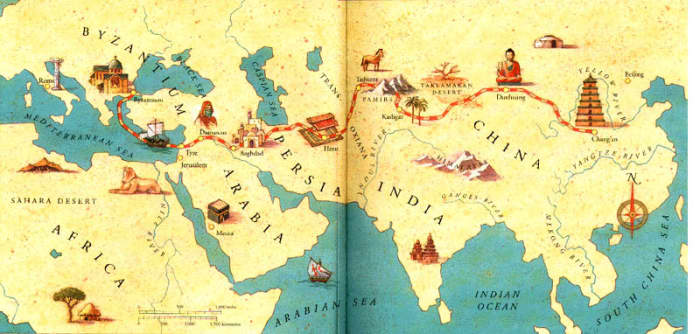Changes and Continuities in Silk Road

The Silk Road
The Silk Road was a trading route, beginning in China and created during the Han Dynasty, which acted as the main artery of trade throughout Eurasia. Running through its veins were not only Asian luxuries and European staples, but ideas, religions, and even disease! From 200 BC to 1450 AD, the Silk Road's patterns of interactions changed with the Black Plague and the spread of Islam and Buddhism, but the Silk Road maintained continuity with the goods that passed along its routes and its main purpose.
Disease, ideas, and soldiers. Three things that made their way along the Silk Road, diffusing into the various countries of Eurasia, between 200 BC and 1450 AD, changing patterns of interactions. During the Middle Ages, a pack of disease ridden rats on a single boat sparked a continental epidemic that would slaughter millions and change the world forever: the Black Plague. Because the Silk Road consisted of both overland and maritime routes, it was a prime medium through which the Black Plague could be spread. Ships carrying the disease would dock at various ports along the Silk Road, and from there the disease could be spread person to person on land. The Silk Road connected Asia with Western Europe; every major city in between was affected by the Black Plague, which its travelers carried. However, disease was not the only intangible item the Silk Road could spread. Ideas were a hot commodity between 200 BC and 1450 AD, and the Silk Road acted as a hub for the dissemination of ideas, which stretched across almost the entire known world. Two ideas in particular were religious in nature: Buddhism and Islam. Buddhism began in China and made its way through the Middle East and into Europe with the help of the Silk Road. Today, giant statues of Buddhist icons can be seen where the Silk Road once was. Islam was spread much in the same way, through Silk Road merchants. Eventually, these two religions became the most widely excepted belief systems in the East! In the period between 200 BC and 1450 AD, change in patterns of interactions came to the Silk Road in the form of the Black Plague, and new religions like Islam and Buddhism.
Despite the changes that disease, religion, and trade relations brought, the Silk Road retained its continuity in the goods that were traded and its main purpose. For the most part, trade commodities stayed the same on the Silk Road throughout the years, in that luxurious goods continued to be sent from Asia. Asian luxuries like jade, spices, incense, gunpowder, and silk, for which the route is named, were things that Europe desired and Asia was willing to give. Europe sent cloth and wool items, Western literature, science, and innovation. The Silk Road was also able to retain continuity in its purpose. Established to make trade between regions easier, the Silk Road continued to fulfill its purpose for centuries, even through the later Opium Wars between England and China. Although The Silk Road's patterns of interaction changed between 200 BC and 1450 AD, continuity remained in that the Silk Road continued to trade the same sort of items and continued to fulfill its purpose adequately.
The period between 200 BC and 1450 AD was a time of disease and death, but also a time of new ideas and new life. The Silk Road observed it all, and even helped some events happen. Changing its pattern of relations, the Silk Road was affected by the Black Plague and new religious ideologies, but continued to trade luxurious goods and fulfill its original purpose.
bruh on October 01, 2019:
this was my least favorite lounge chair i have ever bought!!!!! It broke after 3 day!!! 0.5/5 I would not recommend to anyone! :(
your boy on February 07, 2019:
kinda epic doe
Sd on September 16, 2018:
Thanks just saved we from dieing in a assessment
Al on December 05, 2017:
Honestly, your ideas are a lifesaver. Extremely helpful in formulating my thesis for my CCOT essay
jess on November 30, 2017:
Scroll to Continue
Read More From Owlcation
God bless. I have a WHAP assignment due tomorrow and I'm mentally just stuck. Thanks for helping!
your mother on November 29, 2017:
WHAP is so stupid dude, thanks for saving me
Ethan on November 14, 2017:
Nice thx
nick on October 26, 2017:
bruh Buddhism began in India not in China
Yttad on October 21, 2017:
Doing a whap project thanks so much!
n on January 11, 2016:
god bless you
zz on December 06, 2015:
thx bruh
Inez on April 12, 2015:
You won't believe how much this helped me. Thank you!
Source: https://owlcation.com/humanities/Changes-and-Continuities-on-the-Silk-Road
0 Response to "Changes and Continuities in Silk Road"
Postar um comentário